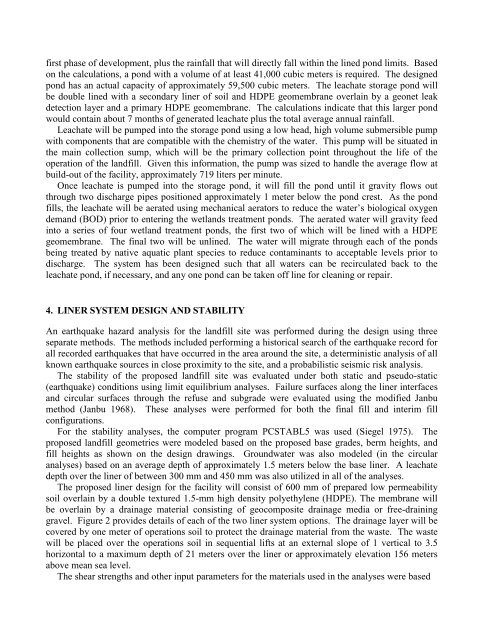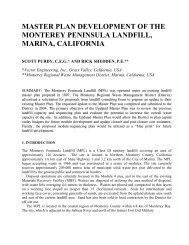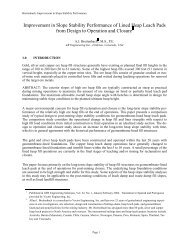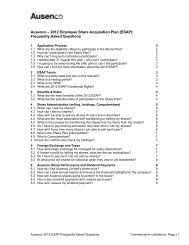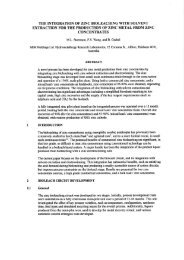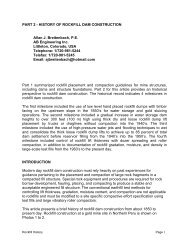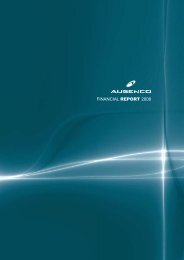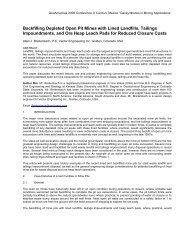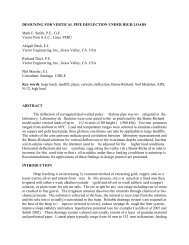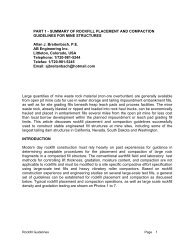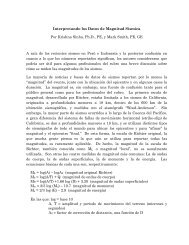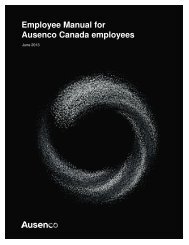SITE SELECTION STUDY FOR A NEW SANITARY ... - Ausenco
SITE SELECTION STUDY FOR A NEW SANITARY ... - Ausenco
SITE SELECTION STUDY FOR A NEW SANITARY ... - Ausenco
Create successful ePaper yourself
Turn your PDF publications into a flip-book with our unique Google optimized e-Paper software.
first phase of development, plus the rainfall that will directly fall within the lined pond limits. Basedon the calculations, a pond with a volume of at least 41,000 cubic meters is required. The designedpond has an actual capacity of approximately 59,500 cubic meters. The leachate storage pond willbe double lined with a secondary liner of soil and HDPE geomembrane overlain by a geonet leakdetection layer and a primary HDPE geomembrane. The calculations indicate that this larger pondwould contain about 7 months of generated leachate plus the total average annual rainfall.Leachate will be pumped into the storage pond using a low head, high volume submersible pumpwith components that are compatible with the chemistry of the water. This pump will be situated inthe main collection sump, which will be the primary collection point throughout the life of theoperation of the landfill. Given this information, the pump was sized to handle the average flow atbuild-out of the facility, approximately 719 liters per minute.Once leachate is pumped into the storage pond, it will fill the pond until it gravity flows outthrough two discharge pipes positioned approximately 1 meter below the pond crest. As the pondfills, the leachate will be aerated using mechanical aerators to reduce the water’s biological oxygendemand (BOD) prior to entering the wetlands treatment ponds. The aerated water will gravity feedinto a series of four wetland treatment ponds, the first two of which will be lined with a HDPEgeomembrane. The final two will be unlined. The water will migrate through each of the pondsbeing treated by native aquatic plant species to reduce contaminants to acceptable levels prior todischarge. The system has been designed such that all waters can be recirculated back to theleachate pond, if necessary, and any one pond can be taken off line for cleaning or repair.4. LINER SYSTEM DESIGN AND STABILITYAn earthquake hazard analysis for the landfill site was performed during the design using threeseparate methods. The methods included performing a historical search of the earthquake record forall recorded earthquakes that have occurred in the area around the site, a deterministic analysis of allknown earthquake sources in close proximity to the site, and a probabilistic seismic risk analysis.The stability of the proposed landfill site was evaluated under both static and pseudo-static(earthquake) conditions using limit equilibrium analyses. Failure surfaces along the liner interfacesand circular surfaces through the refuse and subgrade were evaluated using the modified Janbumethod (Janbu 1968). These analyses were performed for both the final fill and interim fillconfigurations.For the stability analyses, the computer program PCSTABL5 was used (Siegel 1975). Theproposed landfill geometries were modeled based on the proposed base grades, berm heights, andfill heights as shown on the design drawings. Groundwater was also modeled (in the circularanalyses) based on an average depth of approximately 1.5 meters below the base liner. A leachatedepth over the liner of between 300 mm and 450 mm was also utilized in all of the analyses.The proposed liner design for the facility will consist of 600 mm of prepared low permeabilitysoil overlain by a double textured 1.5-mm high density polyethylene (HDPE). The membrane willbe overlain by a drainage material consisting of geocomposite drainage media or free-draininggravel. Figure 2 provides details of each of the two liner system options. The drainage layer will becovered by one meter of operations soil to protect the drainage material from the waste. The wastewill be placed over the operations soil in sequential lifts at an external slope of 1 vertical to 3.5horizontal to a maximum depth of 21 meters over the liner or approximately elevation 156 metersabove mean sea level.The shear strengths and other input parameters for the materials used in the analyses were based


